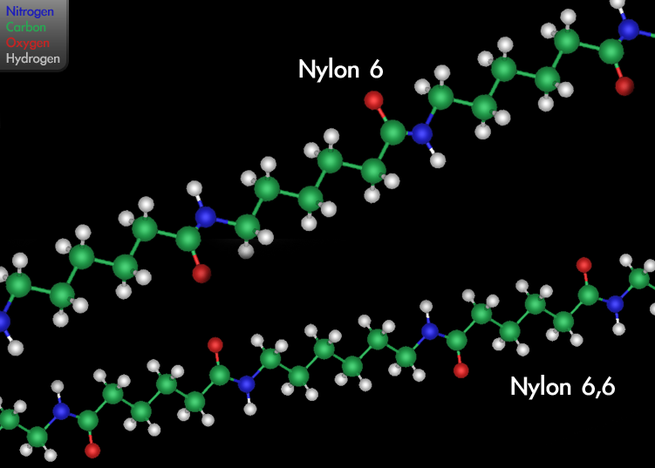Main Difference
The main difference between Nylon and Satin is that the Nylon is a family of synthetic polymers originally developed as textile fibers and smooth, lustrous fabric, usually of silk or synthetic fiber, woven with a long-float satin binding in warp or weft.
-
Nylon
Nylon is a generic designation for a family of synthetic polymers, based on aliphatic or semi-aromatic polyamides.
Nylon is a thermoplastic silky material
that can be melt-processed into fibers, films or shapes.Nylon was the first commercially successful synthetic thermoplastic polymer. DuPont began its research project in 1930.
The first example of nylon (nylon 6,6) was produced using diamines on February 28, 1935, by Wallace Hume Carothers at DuPont’s research facility at the DuPont Experimental Station. In response to Carothers’ work, Paul Schlack at IG Farben developed nylon 6, a different molecule based on caprolactam, on January 29, 1938.Nylon was first used commercially in a nylon-bristled toothbrush in 1938, followed more famously in women’s stockings or “nylons” which were shown at the 1939 New York World’s Fair and first sold commercially in 1940. During World War II, almost all nylon production was diverted to the military for use in parachutes and parachute cord. Wartime uses of nylon and other plastics greatly increased the market for the new materials.Nylon is made of repeating units linked by amide links similar to the peptide bonds in proteins.
Commercially, nylon polymer is made by reacting monomers which are either lactams, acid/amines or stoichiometric mixtures of diamines (-NH2) and diacids (-COOH). Mixtures of these can be polymerized together to make copolymers. Nylon polymers can be mixed with a wide variety of additives to achieve many different property variations.
Nylon polymers have found significant commercial applications in fabric and fibers (apparel, flooring and rubber reinforcement), in shapes (molded parts for cars, electrical equipment, etc.), and in films (mostly for food packaging).
-
Satin
Satin is a weave that typically has a glossy surface and a dull back. The satin weave is characterized by four or more fill or weft yarns floating over a warp yarn, four warp yarns floating over a single weft yarn. Floats are missed interfacings, where the warp yarn lies on top of the weft in a warp-faced satin and where the weft yarn lies on top of the warp yarns in weft-faced satins. These floats explain the even sheen, as unlike in other weaves, the light reflecting is not scattered as much by the fibres, which have fewer tucks. Satin is usually a warp-faced weaving technique in which warp yarns are “floated” over weft yarns, although there are also weft-faced satins. If a fabric is formed with a satin weave using filament fibres such as silk, polyester or nylon, the corresponding fabric is termed a satin, although some definitions insist that the fabric be made from silk. If the yarns used are short-staple yarns such as cotton, the fabric formed is considered a sateen.
A satin fabric tends to have a high luster due to the high number of floats on the fabric. Because of this it is used in making bed sheets. Many variations can be made of the basic satin weave including a granite weave and a check weave. Satin weaves, twill weaves, and plain weaves are the three basic types of weaving by which the majority of woven products are formed.
Satin is commonly used in apparel: satin baseball jackets, athletic shorts, women’s lingerie, nightgowns, blouses, and evening gowns, but also in some men’s boxer shorts, briefs, shirts and neckties. It is also used in the production of pointe shoes for use in ballet. Other uses include interior furnishing fabrics, upholstery, and bed sheets .
-
Nylon (noun)
Originally, the DuPont company trade name for polyamide, a copolymer whose molecules consist of alternating diamine and dicarboxylic acid monomers bonded together; now generically used for this type of polymer.
-
Nylon (noun)
A stocking originally fabricated from nylon; also used generically for any long, sheer stocking worn on a woman’s legs.
“They left the strip club when they discovered the ladies only stripped down to their nylons.”
-
Satin (noun)
A cloth woven from silk, nylon or polyester with a glossy surface and a dull back. (The same weaving technique applied to cotton produces cloth termed sateen).
-
Satin (adjective)
Semi-glossy. Particularly describing a type of paint.

